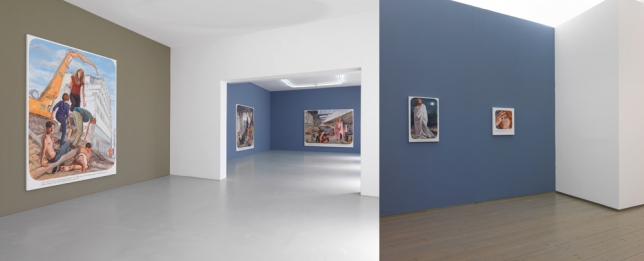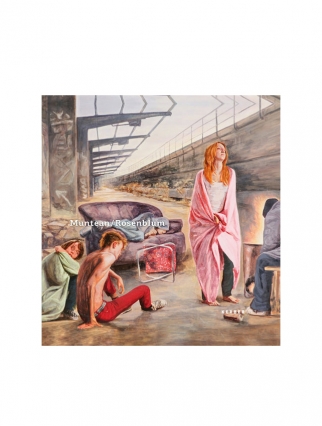03.05. – 07.06.2008
Muntean / Rosenblum
Solo exhibition at Arndt & Partner, Berlin
PRESS RELEASE
Arndt & Partner Berlin is delighted to present the third solo show with works by Muntean/Rosenblum. On occasion of the Berlin Gallery Weekend the exhibition will be taking place over both floors.
Muntean/Rosenblum’s compositional approach to painting is traditional, though as much derived from the collective memory of figuration in popular media (fashion magazines) as it is from the direct appropriations from Renaissance, Baroque, and Neo-Classical motifs. Presented as tableaux of adolescent life, the images are always lozenge-like with a surrounding border of white. In visual terms they are not without similarity to an old-fashioned television set or popular comic images. Written in a hand-script is an accompanying maxim, aphorism, or expressive comment, though it is never directly connected to a particular figure within the image. The texts are emblematic, and form a deliberately ambiguous or liminal content. This is to say they form a threshold in which they are neither explicitly related to the image, but nor are they not related to the painting. The adolescent boys and girls are most often static and gripped with a sense of lassitude. They are young and invariably attractive, but any easily readable psychological content is denied to the viewer. The subject matter constantly slips away from the viewer, and though we recognise these young people through their trendy clothes, their trainers, and their familiar bourgeois lifestyle and material acquisitions, it does not immediately open up any sense and/or wish for a personal identification.
While my analysis might suggest a sombre or negative tone, they are extraordinary images in every other respect. Muntean/Rosenblum show the problematic nature of figurative painting today. In what they refer to as a polyphonic structure, they create a system of precise ambiguity with each element being knowingly self-referential and simultaneously self-critical "one of the main issues is the contemporary notion of the subject and the question of identity." Hence their analysis and investigation of the use of the figurative poses and gestures in painting today, is something of a modern Iconologia.
If we consider Muntean/Rosenblum's pseudo-taxonomic photographs of adolescents (not unlike those Thomas Ruff), with their set poses and repetitions (another important thematic in the artist's works), we find that their ambivalent symbolic translations into paintings is a deliberate act of idealisation – further stressing the subject or sitter's general anonymity and lack of identity. These young would-be sitters are thus appropriated as types, further emphasised as they wear T-Shirt designs painted by the artists. There are no scars or blemishes on these beautiful young people, no violence or overt truculence expressed towards each other, nothing squalid that affirms what is often the natural circumstance and visible reality of the world. The passive figures are made invariably tall, slim and elongated, which indicates they are more about the conventions of painting than merely recognition or storytelling. The figures are not focused on description so much as on their being typological entities – only their material belongings take on a sense of being an identifiable brand. Hence there is no determined line of reading to follow, and in this sense they depart from the conventional notion of the pattern book – they are not prescriptive.
In a paradoxical sense, Muntean/Rosenblum are addressing in painting the opposite of what they appear to portend (a life event), and are able in and through their chosen characters state of general ennui, to show their subjects indexical sense of loss – the adolescent search for meaning and identity. The artist's use of adolescence and youth as a syntactical trope not only reveals the seemingly pessimistic reality of these young lives, but points in a wider sense to the contemporary condition of the world today. A Western world where all forms of secure identity are in a state of continual slippage, as we increasingly experience or abandon ourselves to a state of virtual existence.
In a whole series of recent paintings like there is a decisive shift in formal terms. Rather than their earlier frieze-like presentation there is greater compositional gesture and posed complexity. This is evident in a landscape setting such as Untitled (It was as though...), (2006), where we feel we are looking at a compositional stage set – a Baroque or operatic theatre performance conveyed through the visual relocation into contemporary dress. It is a theatre of compositional interrelations, the foreshortened youth with his arms outstretched forming an arc of inclusion with the cowboy-like figure holding a rifle and seated centre left. The yellow blanket with its V-inverted drapery folds, almost identical with those invented in fourteenth and fifteenth century Florentine painting.
Paradoxically, perhaps, among the most striking achievements of Muntean/Rosenblum, is their ability to have fundamentally digested and elided former distinctions between abstraction and figuration. If modernism set the two positions apart, indeed, created an arbitrary dichotomy between abstraction and figuration, transposing Muntean/Rosenblum's figurative compositions into abstract block relations can be achieved instantaneously in the mind of the viewer. Their paintings seem to suggest they are less about subject matter, than the matter of painting suborned by a subject that merely reinforces their reality as paintings. The artists seem to be saying that contemporary figure painting (as painting) has become something of an echo, a shifting ground that is never certain and/or perpetually indeterminate. Hence their works are not literal paintings of contemporary life in the modernist sense of the tradition instituted by Edouard Manet, and they do not attempt to transcend history painting so much as expose to view its fragile (sometimes facile) and eternally repeatable vocabulary. If they are laments, they are the lamentations of human emptiness, the isolated mantra of an eternal return or incessant repetition. In short the most common commodity of our everyday lives, but particularly so among a youth culture with promised expectations which are easily suffused into an ennui of lassitude and disappointment.
Excerpt from “Double act : two artists, one expression” by Mark Gisbourne, edited by Ulf Meyer zu Küingdorf, Munich, New York: Prestel, 2007. A comprehensive catalogue will be published to accompany the exhibition.

